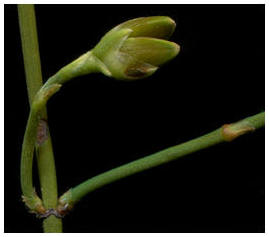Trees and Shrubs of Kern County (Jan
2013, May 2014, July 2015, Jan 2024, Aug-Sep 2025)
Ephedra. Much-branched
shrubs, subshrubs, or climbers, or small trees to 4.5 m (Price 1996)
with simple or usually branched photosynthetic
(green) stems. Basal woody stems when present erect or prostrate, the
erect woody stems simple or irregularly branched above base;
prostrate
woody stem simple or branched forming a network from which
photosynthetic (green) stems arise at regular intervals, the stems
varying in color from yellow green to dark green, jointed, longitudinally
grooved, often with whitish dot-like lines along the intervening ridges;
branchlets appearing opposite along a main axis, or in whorls, or
fascicles, or dichotomously divided. Leaves seasonal, appearing with
cones or after cones, opposite and decussate (each successive pair at
right angles) or whorled, scale-like, partially scarious and connate,
with or without
terminal green photosynthetic segment, 2–3 (-4) per
node, variable on a plant, or on different plants of a species (Foster
1972), base often persistent, aging brown, collar or scar-like. Male (pollen) and female (ovulate) cones usually on
separate plants (dioecious), or plants rarely monoecious,
the cones usually unisexual, very rarely bisexual, or in some species plants
are predominantly monoecious (Price
1996); male cones (1-) 2–10 at branch nodes, each cone with opposite or
whorled sets of scale-like bracts overlapping in a graduated series,
except for the lowermost (proximal), each bract overlying two fused
bracteoles (calyx-like or perianth) from within which arises 2–8
“stamens,” with
filaments
united (sporangiophore), terminating in a cluster of 1–8 bilocular
pollen sacs, often exserted slightly beyond the cone bract; female cones
up to 10 per node, with fewer scales than males, uppermost (distal) pair
or whorl fertile, ovules 1–4, usually 1–2 (-3) mature, each enclosed by two
integuments (hardened bracteoles), elongated to apex in a style-like segment
that forms a pollen
chamber. Cone fruit with 1–2 or rarely 3 seeds, generally known as an arcesthida
(Spjut
1994), or may be classified as an ephedroid carpidium when dry and not winged,
or apterocarpidium if winged, or an ephedroid sarcocarpidium when fleshy
(white, yellow, red, purple (Spjut 2014 umpubl.). Species 55–60 (-71); ~30 in Mediterranean
N Africa, Europe, and SW Asia extending east in dry subtropical and
temperate regions across Asia; ~14 western N
America (including Mexico), ~12 in the Andes (Price 1990). California
has 7or more native and 2 nonnative. Kern County generally recognized
with 3 in flora (Moe 2016), or perhaps 5 to as many 9 species may be
recognized, appearing to be a center of
diversity for dry bracteate fruit types of Ephedra species.
Images for 50 species on SEINet.
Note: Abbreviation cf. (confer) is used when plant
photos and/or specimens differ from species type as circumscribed below based on
their type specimen (holotype, lectotype, neotype). Taxonomic keys to species
of Ephedra have been regarded artificial (Cutler 1939). Populations studies
are needed to identify morphological character attributes that relate to molecular differences.
This is complicated by polyploidy that is reportedly common in Ephedra (Ickert-Bond
et al. 2020; Hu et al. 2021; Rydin et al. 2021; Yu et al. 2023).
Names for species commonly include cf. (confer) where they appear to
deviate from the type while recognized to be commonly identified by that
name without the abbrevation..
The
genus Ephedra (Ephedraceae) is a gymnosperm whose species are
coonly known as joint firs. Fossilized ovulate cones date back to the early
Cretaceous (Puebla et al. 2017), around 100 million
years (mya), whereas pollen
dates earlier—
to the late
Triassic, 200 mya (Puebla et al. 2017, citations; Rydin et al. 2004); however, molecular
studies of extant species indicate that significant evolutionary changes
have occurred only since the Eocene epoch, approximately 34 million
years ago.
Despite its extensive evolutionary history, only about 50 to 74 species
of Ephedra are currently recognized, out of more than 100 species that
have been described (Tropicos, 285 names under Ephedra). Phylogenetic
analyses suggest that Ephedra species dispersed from the
Mediterranean region (encompassing parts of Africa and Europe) eastward
to Asia, subsequently reaching North America and eventually South
America (Ickert-Bond and Renner, 2015; Ickert-Bond, 2004; Rydin et al.,
2021). While the North American dispersal route via Beringia appears
plausible, the presence of Tertiary pollen in the eastern and
southeastern United States (PALYNODATA) may also indicate a dispersal
direction from Europe to North America, as has been proposed for
Taxus (Spjut, 2007). This could represent a secondary dispersal
route stemming from an earlier presence of Ephedra or Ephedra-like
species, as evidenced by seed and pollen findings in Portugal and
eastern North America during the early Cretaceous (Rydin et al., 2009).
The temporal gap between Cretaceous fossils and subsequent Tertiary
diversification may be attributed to the Cretaceous-Tertiary extinction (Bolinder et al. 2016) followed by a
second Eocene-Oligocene extinction from which the surviving species in
the Mediterranean regions then diversified and spread.
Phylogenetic
studies of the genus Ephedra have yet to fully elucidate the
relationships among its species, despite utilizing both plastid and
nuclear ribosomal DNA data (Rydin et al., 2021; Ickert-Bond, 2004).
These studies have included representative individuals from most
species, yet the southwestern North American species remain the least
resolved. It has been suggested that many of these species are
influenced by a history of hybridization, introgression, and/or
polyploidy. However, other processes may also contribute to the observed
patterns, necessitating further analysis of the underlying reasons for
the incongruence. Future research should ideally employ population-level
sampling and low-copy nuclear data (Rydin et al., 2021).
Ephedra species have been utilized in traditional Chinese
medicine for approximately 5,000 years, with "Ma-huang" being the most
well-documented among them. This term encompasses several species,
including E. sinica, E. equisetina, and E. intermedia,
whose stems are employed for the treatment of fever, nasal congestion,
and asthma (Caveney et al., 2001). In North America, Native American
tribes have also harnessed the medicinal properties of seven Ephedra
species (Moerman, 1998). Notably, Ephedra californica and E.
nevadensis have been used in Baja California to address kidney
ailments (Villanueva-Almanza, 2011).
The alkaloid ephedrine, derived from these plants, has been widely used
for asthma treatment and has also gained popularity as a stimulant among
athletes (Mabberley, 1987). While ephedrine is commercially extracted
from the stems of Eurasian species, it is notably absent in New World
species, which lack the necessary ephedrine alkaloids. A comprehensive
review of recent studies examining the biological activity of Ephedra
extracts is provided by Elhadef et al. (2020). Furthermore, Caveney et
al. (2001) reported that the Distachyae group of Eurasian species (Freitag
and Maier-Stolte, 1994) represents the richest natural source of both
ephedrine and pseudoephedrine, with the E. major (syn. E.
distachya) complex being particularly abundant in these alkaloids (Qazilbach,
1971). Between 1960 and 1982, the National Cancer Institute screened 73
extracts from various Ephedra species, identifying seven extracts
with notable biological activity from samples collected in Pakistan,
Turkey, Arizona, and California. Activity was from aqueous extracts in tumors
sensitive to tannins.
Neuroactive amino acids
featuring cyclopropyl ring structures and quinoline-related tryptophan
derivatives, which have been documented in both Eurasian and New World
species, may elucidate their historical applications in traditional
medicine across the Old and New Worlds (Caveney et al., 2001).
Additionally, a diverse array of endophytes flourishes within the stems
of Ephedra, including gall midges (Lasioptera spp.,
Boeklen & Hoffman, 1993) and bioactive fungi (Huang et al., 2008).
Notably, Fusarium oxysporum, isolated from Ephedra fasciculata,
has been identified to produce a depsipeptide known as beauvericin 29,
which exhibits cytotoxic activity against four distinct cancer cell
lines: NCI-H460 (human non-small-cell lung cancer), MIA Pa Ca-2 (human
pancreatic carcinoma), MCF-7 (human breast cancer), and SF-268 (human
central nervous system cancer—glioma) (Turbyville et al., 2006).
Furthermore, another fungal endophyte, Chaetomium chiversii, also
isolated from the same Ephedra species, has been found to contain
radicicol 38, which demonstrates antiproliferative effects against the
MCF-7 cancer cell line (Zhan et al., 2007). These findings underscore
the potential of Ephedra-derived compounds in the development of
novel therapeutic agents for cancer treatment.
The
recent taxonomic work on California Ephedra by Ickert-Bond (2012
in JM2; eflora accessed 12/13/2023) expands and
refines previous species interpretations of E. funerea and
E. aspera. While prior accounts, from Cutler (1939) to Munz & Keck
(1959), Stevenson (1993 in FNA), and Griffin (1993 in JM1), primarily
characterized E. funerea by its geographic range in the "Death
Valley Region, California to Nevada," Ickert-Bond's recognized it to
extend south into the Mojave Desert. Although the traditional
morphological attributes of leaves and cones remain applicable to the
genus, the
proposed taxonomy here integrates other character attributes, notably
seasonal differences in the development of leaves and cones, as observed
by Spjut (2015) for Kern County plants. For example, Ephedra cf.
viridis near Lake Isabella generates leaves concurrently with
cones during Mar-May, in contrast to plants bordering the Mojave Desert
along the the southern Sierra Nevada to the Piute
Mountains region north of Caliente where leaves develop after cones
during July, as also further north along southern Sierra Nevada to where the type specimen
was collected in the Coso Range. This phenological distinction echoes similar taxonomic differentiations in
angiosperms, such as Salix (willows), where species are often
distinguished by whether catkins emerge before or with the leaves. While
coning periods for North American Ephedra species have been
reported (Stevenson in FNA 1993), the systematic recognition of seasonal
leaf development as a key diagnostic character adds a new dimension to
their taxonomy. Furthermore, the inherent variability in leaf
morphology, as evidenced by E. aspera specimens; e.g., Correll
& Johnston 18332 (July 1957) and E. Palmer 1288 (Feb-Oct
1880) in SEINet, underscores the value of these refined, dynamic
attributes in differentiating California's
Ephedra species.
Although
seed
characters such as the number
per cone (1 or 2–3) and their shape help differentiate species of the female plants, the number
of microsporangia seems to have little taxonomic utility at the species
level. The
number of male strobili per node, which does not always correlate with
the number of leaves per node, appears variable in a species, or perhaps
the variation may relate to different species rather than a variable
feature of a species.
Cutler (1939) noted that species of Ephedra can be identified
through anatomical features of the stem, including the number of
vascular bundles, hypodermal fiber strands, cells within a fiber strand,
and the density of stomata per square millimeter. However, the
practicality of quantifying stomata, such as the reported 108 for E.
torreyana compared to 84 for E. funerea, is questionable,
particularly since species variation in these anatomical features has
not been thoroughly studied. Pant and Verma (1974) further supported
Cutler's observations, indicating that species can be distinguished by
the number of stomatal bands in the internodal and nodal areas, which
range from 1 to 4 bands in E. alata to 17 bands in E.
californica and 19 bands in E. chilensis. Variation in the
papillae on subsidiary cells, as described by Pant and Verma (1964),
also may hold taxonomic significance. Moreover, Khalaf et al. (2024)
distinguished Ephedra species not only by stem anatomy but also
by gender for a species. Additionally, in the conifer genus Taxus,
Spjut (2007) utilized differences in the numbers of leaf stomata rows
along with the number of adjacent rows epapillose marginal cells to
differentiate species. These differences were shown to have
phytogeographical significance, lending further support to the taxonomy
of species in the genus, in which species show little change since the
mid Miocene.
Although California is reported to have six native species (Ickert-Bond
in JM2), E. torreyana is
an additional species that has been found in the Death Valley region
(Sanders et al., CCH specimens, 2011, 2012, Calflora). Villanueva-Almanza and Fonseca (2011) reported E.
antisyphilitica to occur
in Mexico near the California border—Mexicali and Ensenada; thus, it too
may be in California; however,
E.
antisyphilitica
mostly occurs from southern Texas to northern Mexico. Ephedra
torreyana,
which reportedly hybridizes with other species (Stevenson 1993), is
distinguished by the midnerve on ovulate bracts, pale
orange sword-shaped (lanceolate) nerve (or orange -yellow
to greenish -yellow, in contrast to the
broad elliptical pale orange-red
nerve in seed
cones of E. funerea. Leaves
of E.
trifurca,
which has
a similar orange colored
nerve, differ in being narrower and longer and not recurved from the tip with age as in E. torreyana; instead, they shred with
age as in E. funerea. Ephedra trifurca is
also distinguished by the rigid branches ending in a sharp spine where
leaves appear absent, and by
the relatively long linear leaves where they are commonly seen near
apex..
In Kern County, three species are relatively common, Ephedra
californica, E. nevadensis, and E. viridis. A helpful
character to separate them is the angle of branching, nearly at right
angles (60–80°)
in E. nevadensis, ~30° in E.
viridis in which branches appear erect and nearly parallel to
one another. The angle of branching in E.
californica, ~45° (Cutler 1939; Stevenson 1993), is thus intermediate
between the two other species, while their erect to spreading growth
resembles E. viridis; however, the leaves, when present—that occur in
three's—easily identifies E. californica in Kern County.. Nevertheless, the reported occurrences of
E. californica east of the Southern Sierra foothills need study,
and also with E. nevadensis. especially where the species overlap with E. funerea and
E. trifurca in San Bernardino County and further north as seen in
CCH2 specimens identified E. californica, E. funerea, and E.
trifurca. Although E. funerea and E. trifurca are
alleged here to be sympatric, they can be distinguished by grayish green
vs. green color (pale or yellow green in E. trifurca), and by
absence (E. funerea) and presence of long linear leaves near apex
(E. trifurca), which are characteristically present in E.
trifurca (see illustrations in McMinn 1939).
Ephedra aspera has been reported near the
Kern County line along
Hwy 58, while I have only seen E. nevadensis in the region—where
locally common in creosote scrub (Larrea tridentata shrubland
alliance). Shrubs with well-developed erect woody stems and orange
pollen cones along the Pacific Crest Trail near Walker Pass extending to upper Jawbone
Canyon, have persistent leaf bases similar to an
illustration of E. aspera in Powell (1998), described in the key
below as cuspidate-recurved, while another kind of leaf also seems to
develop as seen in the isolectotype (US), but not evident in a male syntype.
Leaf development on an
Ephedra plant can vary considerably (Ickert-Bond and Renner 2015),
and occasionally more than one leaf
type
can be found on a
plant as shown for E. viridis near
Lake Isabella.
A fourth species in Kern County, Ephedra arenicola, was
discovered in Squirrel Canyon in the Piute Mountains (Spjut 2015, CNPS
Kern Chapter newsletter). The
identification was determined by comparison to the type specimen collected
from Apache County, Arizona. This was described by Cutler as a hybrid
between E. torreyana and “E. coryi var. viscida” [E.
cutleri]; however, the unusual character feature of the distal
bracts of seed cones exhibiting raised mid and lateral nerves, and
geographically disjunct, justifies species
status (without hybrid designation). The leaves of the E. arenicola type
are remarkably similar to those seen on the E. aspera type. Based
on this and the rough appearance of the dark green stems, E.
arenicola would seem to be a distinct species that was more widely
distributed and has since evidently hybridized with E. aspera in
Apache County, AZ, and
E. viridis in Kern County, CA.
Ephedra
funerea
has also been reported in Kern County based on identification from a
software photo determination, Plantnet (Calflora with reference to iNaturalist
addition 11/26/2008, but photo not included, observer Del Faverno
(Bristlecone Chapter, location accuracy 50,000 sq km). Another Kern
County collection reported by Bartholomew and Boufford 04/20/1985, 28 km
E of Interstate Highway 5 on State Highway 138 (CCH1, herbarium
specimen) was searched for in 2013 without success .
This location, which is about 3 km south of the Kern County line in Los
Angeles County, appears to have had its vegetation cleared at some time
in the past.
An
Ephedra
found along Erskine Creek in the Piute Mountains has a vine-like habit
with pollen cones at end of long arcuate branches (Erskine Creek
plants), was originally thought to be E. viridis. Although these features
also suggest E. pedunculata, a species known from southern Texas and
northern Mexico, upon further review as of Dec 2023, it is
referred to Ephedra foliata, a widely distributed Mediterranean
species that extends from the desert regions of northern Africa to
western India. Here
it may be noted that the Mediterranean E. foeminea, an Eurasian-North
African species, was discovered growing in Santa Barbara County where
possibly naturalized (CCH2, identified by Ickert-Bond). It is
distinguished from all other Kern County species by the red fleshy
bracts (JM2), which collectively a fruit, are likely dispersed by birds (see photo of species
by Ori Fragman-Sapir, JungleDragon.com).
Along the Kern River near Lake Isabella is an Ephedra with erect pale green stems arising
from a much-branched
network of horizontal, rhizomatous-like, woody stems, spreading over 10
m; it has been tentatively referred to Ephedra cf. nevadensis;
however, its hedge-like growth form is remarkably similar to images of
E. cutleri reportedly common in eastern Utah for E. cutleri (Al Schneider,
pers. comm. & photo on website, Sep 2025), and Max . It differs from the
typical form of the Nevada ephedra by the flexuous (not rigid) whorled
branches not as wide spreading. A common growth form of E.
nevadensis, which seems not to have been properly described for the
species, differs from E. cutleri by photosynthetic stems
developing from a thick columnar trunk, comparable to columnar cacti
similar to Carnegeia, or to the ocotillo, especially
Fouquieria columnaris, but usually < 2 m high, while its entire
trunk form is usually difficult to discern through the thorny dense
growth of photosynthetic stems that originate from the ephedra trunk.
Occurring with the Ephedra cf. nevadensis (or E. cutleri)
at south Lake Isabella is Ephedra
cf. viridis. It differs from typical arborescent form by the lack
of trunk-like base and the development
of long narrow linear green leaf segments, either from the axils of
non-photosynthetic
scale-leaves, or
from their tips, which appear to soon wither and drop. They
both cone during March to May.
Ephedra cutleri is generally viewed as closely related to E.
coryi (Cutler 1939, E. coryi var. viscida), which
differs by absence of a "viscid" surface on stems (Cutler 1939), treated
also as a variety of E. viridis . Both occur along the Kern
River, north into Tulare County. They differ in rhizomatous growth that
can be seen at the base of plants without any digging, open dichotomous
in the putative E. coryi and reticulate in E, cutleri
(Images Al Schneider; SEINet).
An additional character for both of these species is the epicormic
growth of shoots from nodes of the photosynthetic stems as seen in many
herbarium specimens (SEINet), in contrast to adventitious development in
other species of Ephedra. The terms adventitious shoots,
epicormic shoots, and layering refer to different strategies of
regeneration and vegetative reproduction. Adventitious shoots
develop spontaneously from buds lacking a vascular connection to the
meristem or pith (Kormanik & Brown 1967), although they may originate
from a type of epicormic bud (Meier et al. 2012). They may form locally
from buds associated with callus tissue resulting from injury.
Epicormic shoots, in contrast to adventitious shoots, are recognized in
this paper as a regular developmental pattern on the aerial system of
the tree such as on the bole and/or branches. They originate from
dormant buds in or beneath the stem-bark with a connection to the
vascular tissue, and become activated—upon stress such as fire or sudden
exposure to light—to produce new branches (Kormanik & Brown 1967; Meier
et al. 2012). Epicormic bud initiation is determined by the ‘genetic
growth plan’ (Meier et al., 2012). Taxus brevifolia is a good example of
epicormic shoots
Two proposed
species of Ephedra new to Kern County, not referenced by species
names, are simply referred to as
Ephedra sp. A that occurs along Erskine Creek, and north of
Caliente below Stevenson Peak, and
Ephedra sp. B photographed in Box Canyon near Stevenson Peak. The
latter is also
recognized in Inyo County near Darwin (pers. obs. May 2015), and from
an image on Calphotos, taken in Washoe County, NV. These appear
related to E. cutleri known from the Four Corners
region of U.S. by its hummock appearance.
"stalked" two-seeded cones and "viscid" stems (Cutler 1939;
Cronoquist et al. 1972), but here
recognized to differ by their hedgelike growth.
The following key is tentative due to species concepts in Ephedra that have varied among the treatments over time (Cutler 1939;
Munz & Keck 1959; Stevenson in FNA 1993; Griffin in JM1 1993;
Ickert-Bond in JM2). The focus here is on species reported or expected to occur in
Kern County, while reference is to made to outside the county. The abbreviation “cf.” (confer) indicates deviation from the
type specimen and/or what has been generally described for the species. Although the number of scale-leaves implies a
diagnostic feature for recognizing species, its application probably
does not reflect the natural relationships as evident from their
variation in shape, texture, color, connation, and persistence observed
within a “species” from different locations and also from comparing
species descriptions among the floristic treatments. Further,
species of Ephedra do
not generally fall into the ecogeographic patterns of other plant
species as noted for E.
californica in
MCV2. Detailed
field studies during development of cones and of leaves are needed along
with DNA. As
reported by Cutler (1939), about
two-thirds of the herbarium specimens he studied could not be
confidently identified, while he also indicated that his key was
“artificial.” The habit of the plant appears to be a useful taxonomic
feature, and photographers might focus on getting a good close-up of
internal branching along with leaves and cones when available.
Nevertheless, there always seem to be exceptions lending support to
classifying Ephedra species by leaf arrangement and number of
seeds per cone.
Key to Species of Ephedra
(for those known or expected to occur in Kern County)
1. Green (photosynthetic) stems
scrambling over rock talus, vine like;
branching below apex opposite
at 90°; pollen cones solitary at end
of long
arcuate branches, and
occasionally sessile along main stem;
native from
Mediterranean northern Africa
to India;
rare in Kern
Country, Erskine Creek in the Piute Mountains ..........................
Ephedra foliata
1. Green stems erect and spreading. regularly branching in whorls,
or dichotomous < 90°
.........................................................................................
2
2. Leaves mostly whorled (3), seeds usually one
.................................................... 3
2.
Leaves mostly opposite, seeds one or two
......................................................... 5
3. Green stems
4-angled, zigzag from node to node;
seed
unknown; plants with numerous low scrambling stems
on steep slope; Piute Mts. (Caliente region) ...................................
Ephedra sp.
3. Green stems round
(x-sect.),
relatively straight
....................................................... 4
4. Photosynthetic stems
dark to pale green, usually not sharply pointed,
cone and seed generally obconic; leaves often appearing with cones,
ovate-lanceolate to lanceolate with a dark median
strip, recurved with age;
generally foothills
of San Joaquin
Valley in Kern County
...
Ephedra californica
4.
Photosynthetic stems
gray green, spine-tipped, seed ellipsoid to conic;
leaves often absent when cones present, drying white, shredded,
papery;
Mojave Desert, reported near Kern County
line .....................
Ephedra funerea
5.
Green stems fastigiate, closely ± parallel to one another for most of
their length ....... 6
5.
Green stems spreading widely in branching above base, at least some >
30°
.......... 14
6.
Main stem with whorls of erect short leafy (epicormic)
shoots,
leaves
at short
intervals, overlapping nearer apex;
cones solitary, sessile, oriented
perpendicular
to stem; Piute Mts. (Stevenson Peak, Piute Mt.), also
Inyo Co
near Death Valley NP
and Washoe Co.,
NV....................
Ephedra sp. B
6. Main stem with
relatively long internodes, branches whorled or not .....................
7
7. Plants with
ascending to
±
erect
single woody trunk, often branched, to
2 m or more; photosynthetic stems rigid, often dark green;
coning in
spring;
leaves developing in summer to fall, opposite........................................
8
7.
Plants
low to medium sized shrubs < 2 m; photosynthetic stems often
bright green, rigid or flexuous, arising from a
rhizomatous or
ground dwelling ground stems, or from woody stems
spreading
outwards from center, or in
small aggregate clusters from a central root,
or
more widely separated along ground (stoloniferous-like) by a
primary woody stem; leaves
late winter to spring, often appearing
with cones
................................................................................................... 9
8.
Seed 1, ellipsoid to subcylindric, tapering to apex above mid
region; leaves
at nodes connate–urn-like,
swollen around base, aging gray, funnelform
on young (or epicormic) shoots and peduncles, connate to near
apex where divided (V-shaped) and broadly
tapered to apex;
(lobes triangular); pollen cone bracts
±
turgid, retaining shape in dried
specimens; mostly sw Texas to northern Mexico, west along border
(Stevenson,
FNA), type from Coahuila has similar leaves on young
shoots and stem features to
type for E. viridis from
Inyo Co. (CA)
....................................................................
Ephedra aspera
8.
Seeds 2,
trigonous, or flat on inner side, broadly ellipsoid, rounded
to apex
from well above above mid region; stems dark green;
leaves on young shoots funnelform, puckered at base
(summer),
orange,
U-shaped where lobes unite
below,
collar dark
brown,
with or
without
some gray; pollen cones with fleshy bracts, appearing
shriveled in
herbarium; seed maturing pale to yellowish brown to dark
brown;
western Mojave Desert, Sierra
Nevada
(type from near Crystal Springs
in Coso
Range, Inyo Co.) ......................................................
Ephedra viridis
9. Broad flat-topped to hummock-like
shrubs with ± erect
stems 1-1.5 m, arising from rhizomes and/or horizontal
aerial
ground stems;
frequently branching > 30º in a
± reticulate
network;
seed cones on short erect to abruptly ascending peduncular
branches
at nodes among
whorls of branches, or opposite at nodes, or
terminating an erect stem from a horizontal
ground stem or
rhizome; epicormic (young) shoots common in
whorls at nodes;
seeds usually two, brown to
blackish brown; generally
reported from the Four Corners Region, type from Apache Co.,
AZ; here reported from Kern
County where distinguished by
flat-top (hedge-like) growth in spreading
from a network of ground
horizontal stems ......................................................................
Ephedra cutleri
9.
Shrubs with ascending stems in clumps, or
with erect fastigiate
stems; seed cones
nearly sessile,
or if on long peduncles not in whorls
around nodes
............................................................................................... 10
10.
Distal bracts of seed cone (1-) 3 (-5) nerved, seeds 2; Apache Co.,
ne AZ near Dennehotsco (leaves
connate to near apex),
Kern Co., Squirrel Canyon, leaves not evident (spring) ............
Ephedra arenicola
10. Seed cone bracts
not distinctly nerve like .............................................................. 11
11.
Cones appearing without leaves, monoecious
.....................................
Ephedra sp.
11.
Cones appearing with leaves, dioecious; E. viridis complex
.............................. 12.
12. Leaves
appearing with cones, variable on a plant, with or without long
terminal linear green extension to 5 mm or more from orange
puckered
base; Kern River near Lake Isabella; Piute Mts
......................
Ephedra cf. viridis
12. Leaves appearing
with or without cones during spring, similar
throughout, or only cones appearing without leaves
......................................... 13
13. Leaves appearing with cones, orange base not swollen;
Piute Mts...........................................................................
Ephedra cf. viridis
13. Leaf bases swollen
with short terminal green leaf segment;
Kelso Valley
.......................................................................
Ephedra cf. viridis
14.
Stems
±4-angled; yellowish green; nodes with dark
brown collar;
seed
cones on short to long peduncle-like branches; growing from rock
crevices,
Piute Mts.
(Stevenson Peak, near Caliente, Erskine Creek) ............
Ephedra
sp. A
14. Stems mostly round,
often grayish green; persisting leaf parts gray to
white-scarious, deciduous; node collar white .....................................................
15
15.
Stems rigid, grayish to pale green; branches in whorls, spreading
60°
(-90°);
seeds 1-2 (-3)
...................................................................................................
16
15. Stems flexuous or
rigid,
pale to dark green or yellow
green; branches in whorls or
bifurcating
< 60°;
seeds 1 (-2) ............. ..............................................................
19
16. Seeds 1 (-3), narrow ellipsoid to bottle shaped, ~3×
longer
than wide; leaves in 3's; branches spine tipped; Mojave
Desert;
Mojave Desert. reported near Kern County
line............................
Ephedra funerea.
16. Seeds 2, although not always equal in size,
or 1 aborts, broadly
ellipsoid,
6–9 mm, ~2×
longer than wide, brownish, flattened
on inner surface; pollen cones with basal scales spreading
wide
at maturity; leaves 2; stems not spine
tipped; southern Sierra Nevada,
Mojave Desert in Kern county;
Ephedra nevadensis
complex ...................... 17
17. Seed cone bracts incurved—tapering to summit of cone,
appearing,
capsular,
bracts deciduous at maturity similar to a 4-valvate capsule;
rare, southwestern Mojave Desert ne of
Mohave
..................................................................
Ephedra
cf.
nevadensis
17. Seed cones bracts not valvular,
< seed length, two closely
clasping the
seeds, the other two
oriente between seeds
................................................18
18.
Photosynthetic arising from reticulate network of aerial
rhizomatous-like
woody stems;
1 of 2 seeds
often partially aborting;
Kern River,
south
end of Lake
Isabella (possibly a hybrid
from growing in association with
E. viridis)
......................................................................
Ephedra cf. nevadensis
18. Plants forming discrete
bushes with many whorls of rigid
.branches; common in Kern
County.....................................
Ephedra nevadensis
19. Plants with horizontal (woody or green) basal stems bearing erect
whorls
of green stems at regular intervals; green branches often flexuous,
appearing
almost filiform; persistent parts of leaves short oval white to gray
above collar;
cone bracts pale yellow with elliptical dark
mid area in seed cones; seeds 1(-2),
conical,
widest below mid region, long tapered to pointed apex, longitudinally
furrowed, > 8 mm long; possibly in
Kern
County; eCA, wAZ,
sNV, sUT .............................................................................. Ephedra fasciculata
18. Plants
low discrete shrubs < 1 m high, with irregularly spreading branches (to
40°);
seed 5–8 mm; generally occurring below 1,000 m in
Sonoran Desert ....... E. clokeyi
.
Nomenclatural data and Descriptions of Ephedra
species
Ephedra arenicola
Cutler 1939 (“X E. arenicola,”
putative hybrid between E. torreyana and E. cutleri).
Shrub to 1 m, with whorled branches, spreading ~35⁰;
leaves persistent and opposite in type specimen, of two kinds as seen in
E. aspera, (1) connate and slightly wedge-shaped with a prominent
mid nerve, shortly broad deltoid to apex, and (2) cuspidate without mid
nerve, acutely tapered to recurved apex; seed cones in pairs; lower seed
bracts keeled, upper bracts 3 nerved; seeds acutely tapered to apex.
Type from Apache Co., AZ, 5 miles south of Dennehotsco. Also recognized
here to occur in Squirrel Canyon, Kern County; specimen from one plant
collected, remarkably similar in development of paired seed cones, seed
shape, and the strongly 1-3 nerved bracts (see images above).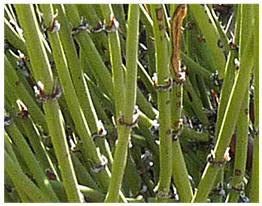
Ephedra aspera
S. Watson 1883. [Ephedra
nevadensis S. Watson 1871 var. aspera (S. Watson) L. D.
Benson 1943]. Excludes Ephedra clokeyi Cutler 1939 [Ephedra
fasciculata A. Nelson 1934 var. clokeyi (H.C. Cutler) Clokey 1945]. Rough
ephedra, boundary ephedra. Shrubs with stiff erect closely parallel
branches, to 1.5 m; older stems with fissured bark, photosynthetic
shoots rather thick, ~ 3 mm diam, dark green, yellow with age, rough and
papillate, smooth and glaucous between ridges, branching opposite or in
whorls of 3 or 4, at angles of ~35°,
whorls of branches often at frequent intervals;
scale-leaves in 2’s
(rarely 3 per node), 1–3.5 mm long, united half or more of their length,
persistent in the typical form (with seed cones), or the sheath
splitting, fibrous, swollen at base; leaf collar brownish; pollen cones
yellow to orange, drying
reddish brown, with broad rounded (elliptical) bracts; seed 1,
± broad ellipsoid,
tapering to apex from above mid region, or trigonal, 5–8 mm, tan to chestnut
brown. Cones developing late winter to spring (Stevenson), leaves
summer to fall .
Reported to be widely distributed in deserts of the southwestern North America,
mostly below 5,000 ft, generally Mojave and Sonoran deserts as far
south as the Magdalena Desert in Baja California (Turner et al. 1995),
to the Chihuahua Chihuahua Desert Texas and south into Mexico,
also reported in the western Great Basin Desert. Type from the Sierra
Madre in Coahuila, 40 miles south of Saltillo, Mexico [Palmer 1288,
implied by Watson but not the only specimen referred to; lectotype
designated by Cutler (1939) with reference to specimen at MO (Tropicos.org.
Missouri Botanical Garden. 22 May 2015 <http://www.tropicos.org/Image/45632>,
low resolution, sheet with 2 specimens with different labels, specimen
appearing to have seed cones annotated by Cutler as “TYPE ”);
isolectotypes GH, NY UC, US (high resolution image, 2 specimens with two
labels, one with seed cone has persistent connate leaves, annotated
syntype by Ickert-Bond, May 2002); the other with pollen cones,
Palmer s.n., 1880, with handwritten annotation, reference to
Cutler(?), “duplicate of type,” lacks connate leaves]. Kern Co.:
Reported records all questionable. Ft. Tejon & vicinity, Xantus de Vasey 112, collected 1857-58 (US!, syntype for E. nevadensis, annotated E.
aspera by Ickert-Bond (but no seed, thus, questionable).
CCH-two records: (1) N. Cooper, 19 Apr 1949, from County line west of Kramer
along US Hwy.466 (Hwy 58), 2800 ft (n.v.).
Specimen at HUH! with mature pollen cones collected by Abrams & McGregor
between Tehachapi and Mojave, 28 Jun1908, was annotated and cited by
Cutler (1939) as Ephedra aspera; it is E. nevadensis as
was determined by the collectors. Plant photos and specimens identified
E. aspera from California
(Ephedra aspera
links:
SEINet,
Calflora, Calscape)
all appear to be low shrubs with irregular wide spreading branches;
they can be referred to E. clokeyi .
Ephedra aspera typically
is an erect shrub arising from woody trunk judging from photos (Reis
Lindley, SEINet; Peter Koch in Warnock
(1970, Wildflowers of the Big Bent County, Texas) with closely
fastigiate dark to dull green rigid stems. Although the type specimen
from Mexico reportedly collected during July has both cones and leaves,
in other specimens identified E. aspera from Texas to Arizona,
leaves are often absent. This is in contrast to specimens reportedly
collected during
July-Oct that were seen without
cones in which
leaves are conspicuous at all nodes.
Ephedra aspera was interpreted by Ickert-Bond
(JM2) to include E. fasciculata that had been previously
recognized in Munz & Keck as a low often prostrate plant with flexuous
branches
without cones. However, Ephedra aspera was not recognized
to occur in California in earlier floras (Jepson, McMinn, Abrams),
whereas E. fasciculata—that was recognized by Griffin (TJM1)—was
referred to as a synonym of E. aspera by Ickert-Bond (JM2); but
mentioned more recently among 54 species in Ickert-Bond and
Renner (2015).
Ephedra fasciculata may be recognized by trailing ground stems
bearing whorls of erect green stems at regularly spaced nodes.
Ephedra fasciculata and the related E. clokeyi were
distinguished from E. aspera by elliptical shape of ovulate scales
and by the dark brown furrowed seeds in contrast to the orbicular scales
and non-furrowed light brown seeds of E. aspera (shallowly
furrowed); E.
fasciculata was then separated by seed length, 8–13 mm, in contrast
to 5–8 mm for E. clokeyi (Cronquist et al. 1972; Munz & Keck
1959; Shreeve & Wiggins 1964). Seed of E.
fasciculata in most cone specimens on SEINet appear narrower and
acutely tapered to apex from below mid region. This is in contrast to a more plump (oval in
outline) in E. aspera specimens. Ephedra
fasciculata seems best distinguished from E. aspera by its
smaller shrubby habit with rhizomatous-like basal stems from which arise
erect whorls of branches. Plants without
cones may be recognized by persistent cuspidate recurved leaves, in
contrast white parts often seen above the collar in E. fasciculata. California
plants, which may be distinguished as E. clokeyi, reportedly have
shorter seeds (Cutler 1939) and do not appear to spread from base.
Although the circumscription of E. aspera has varied
among different floristic treatments, key features in common are the
usually single seed (appearing 4-angled near apex in type) and opposite leaves in contrast to the two seeded
“cones” of E. nevadensis and E. viridis, also with opposite leaves, in further contrast to the whorled leaf arrangement
in other species. Branchlets of E. aspera are often numerous—in
fascicles—growing erect, closely parallel, and rigid. Ephedra
viridis is most similar in habit, and difficult to distinguish in
sterile leafless plants.
The type specimen
of E. aspera (high resolution image at Smithsonian Online
Herbarium Collections) exhibits two developmental kinds of leaves, one
appears associated with vegetative growth as seen near base of specimen
where persistent leaves resemble a
short urn by their inflated base; the other not swollen but longer
and
connate to ~7/8 of their length
with triangular lobes not recurved, which can be
observed at base of seed shoots and on young shoots, in the axils of old
leaves on older shoots as well as at apex of stems. This latter type of
scale-leaf is distinctive but rarely seen in herbarium specimens
identified E. aspera; but see specimen Correll & Johnston 18332,
reported to have been collected 22 July 1957 (LL, TEX, on SEINet).
See also Ickert-Bond and Renner (2016, Fig. 4)
Ephedra peninsularis I. M. Johnston 1922, described
from Magdalena Island, was interpreted to be widely distributed in Baja
California; however, it has been generally treated as a synonym of E. aspera.
Its type (isotype, GH, HUH & Libraries, image) shows less
tapered
pollen
cones with well exserted anthers. An Ephedra I collected on
the Vizcaíno Peninsula near Puerto Nuevo was noted to be unusual for the
blood red sap.
Not surprisingly, the geographical ranges of these species
have also varied according to different authorities. Stevenson (FNA
1993) showed E. aspera to reach its northernmost distribution
along the US/Mexico boundary—from California to southwestern Texas;
hence, the common name boundary ephedra. Griffin (JM1 1993) indicated a
much wider range for E. aspera—a more northern occurrence,
extending into the Mojave Desert as previously recognized by Munz & Keck
(1959). The treatment by Ickert-Bond (JM2) extends the range further
north—into the Great Basin Desert of the California flora for which
there is a specimen in CCH (Ickert-Bond annotation)—that reported its
collection site 25 miles east of Lee Vining, 2296 m. Ephedra aspera
also occurs southwards into mainland Mexico and along the Pacific Coast
in Baja California Sur (Turner et al. 1995; see also CIRH).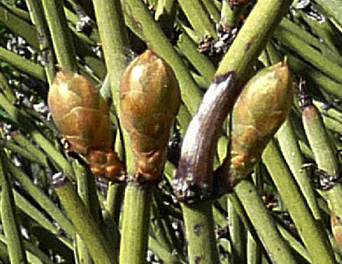
Ephedra californica S. Watson 1879.
Desert tea, California joint fir. Shrub with numerous densely tufted
erect green stems (caespitose) from a short
woody base, or small tree with a definite single trunk; photosynthetic
stems (branchlets) green to yellowish green, most branchlets spreading ~45°,
often
not closely parallel to one another; scale-leaves in 3's (rarely 2, or
4), united
at first, with a greenish or reddish brown medial thicker part, soon
splitting with the tips curving backwards (recurved), the basal collar
bulging (typical form), darkening with age; cones usually 3 per node;
seed solitary, ovoid (type), globose, ellipsoid, or obovoid (Kern Co.), 1–1.5 (-2)× as long as
wide.
Scattered occurrences in diverse habitats below 4,000 ft;
grasslands of Inner South Coast Ranges near Gilroy in California,
coastal strand near San Diego, Peninsular Ranges in California and then
south in various habitats to near Bahía Tortugas, Vizcaíno Peninsula (CIRH,
Turner et al. 1995). Also Panamint Range, eastern ranges of Death
Valley near Nevada state line, sand dunes and washes in the Mojave
Desert, southern Sierra Nevada in Kern Co., Tehachapi Mts., and then
south to the Sonoran and Chihuahua deserts of southeastern Arizona.
“Californica joint fir scrub” (alliance) recognized in MCV2 when ≥ 2%
absolute cover in the shrub layer, noting also that the ecology of the
species is poorly known. Type from San Diego Co., Jamul Valley.
Original material includes two specimens with leaves collected by Edward
Palmer in 1875, Palmer 864 & Palmer 865 mounted on one
sheet (HUH-GH!),
without cones except for two seed (Palmer 864) and two immature
pollen cones (Palmer 865) mounted below each specimen reported to
have come from attached specimen packets, scales and seed for one cone
separated, its associated specimen (Palmer 864) has leaves
recurved near apex,
designated
"Type" by Cutler 1939, and lectotype by Ickert-Bond, May 2002, the other
with leaves recurved to near mid region and its associated two pollen
cones below annotated syntype by Ickert-Bond May 2002, the specimen
reportedly collected from San Diego, San Diego Co. Kern Co.:
“Occasional in the California juniper belts from Recruit Canyon and the
Panorama Hills in the southern Temblor Range to the east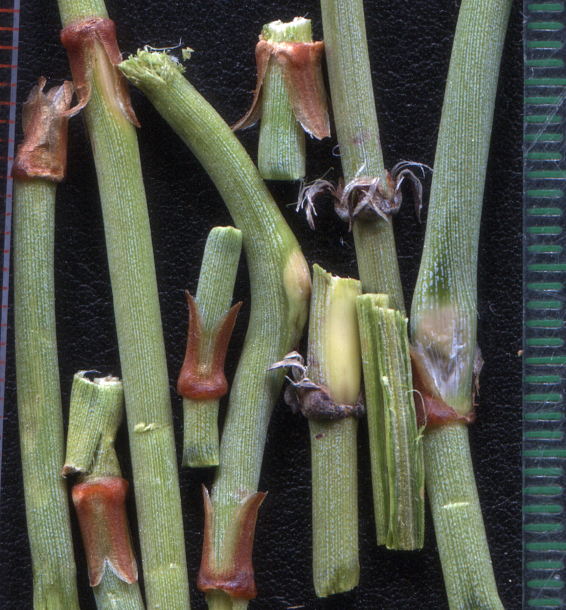 end of Cuyama
Valley (where unusually large plants grow on the sand flats),
and along the sandy foothills on the east side of the valley from the
mouth of Kern Canyon south to Comanche Canyon in the Tejon Hills,”
73–1,300 m (CCH excluding suspected misidentifications). Also common on steep loose sedimentary rocky banks in Caliente Creek Canyon (pers.
obs.). Plants from near the Death Region shown in CCH2 under E.
californica may be identified var. funerea; e.g.,
Annable 557 collected in the Funeral Mountains. Ethnobotanical (Moerman): Diegueño Infusion of branches to purify blood,
improve
appetite, or to relieve stomachaches from eating too much, and for
kidneys.
end of Cuyama
Valley (where unusually large plants grow on the sand flats),
and along the sandy foothills on the east side of the valley from the
mouth of Kern Canyon south to Comanche Canyon in the Tejon Hills,”
73–1,300 m (CCH excluding suspected misidentifications). Also common on steep loose sedimentary rocky banks in Caliente Creek Canyon (pers.
obs.). Plants from near the Death Region shown in CCH2 under E.
californica may be identified var. funerea; e.g.,
Annable 557 collected in the Funeral Mountains. Ethnobotanical (Moerman): Diegueño Infusion of branches to purify blood,
improve
appetite, or to relieve stomachaches from eating too much, and for
kidneys.
Leaves
of plants in Kern
County plants such as shown here from bluffs along Caliente Creek, were
not found with cones during March but in late July after a
summer rain.
E. californica
links to
SEINet,
Calflora,
Calscape.
Ephedra coryi
E. L. Reed 1936. Subshrubs
spreading under ground over broad areas by rhizomes; plants often
appearing with erect or wavy stems that are bright green, pale yellow
green, or grayish green, closely fastigiate (<22º) in tufts;
,
appearing herbaceous in new growth with deciduous conic apical buds,
appearing short lived by fallen stems that lay loose on ground among
erect stems, their presence conspicuous by aging yellow in contrast to
the bright green erect stems; leaves similar to those in typical E.
aspera, opposite, on young shoots connate, funnelformn, united most of their length, divided into short
triangular lobes near summit, lobes broadly tapered
to a pointed apex; pollen cones nearly sessile where obscured at base by
funnelform scale leaves, on peduncles varying in length on an individual
plant from nearly sessile to terminal on peduncles to 4 mm (lectotype),
usually in pairs, sporangiophores relatively thick and often well
exserted; seed
cones 2-seeded, in whorls on short to long peduncles associated with
whorled branches at nodes, but also appearing conspicuous at the tips of
erect branches. Type from Brownfield, Texas,
Reed. 4147, 29 Apr 1935 (US). Lectotype designated
by Cutler, Ann. Mo. Bot Gard. 26: 413, annotated by S. Ickert-Bond,
May 2002. Plants extensively rhizomatous (underground), appearing
dichotomously branched not at right angles. Stems erect, bright
green to gray green.
Stevenson (FNA,
1993) distinguished
E. coryi (sandy
desert, wTX ) from E. viridis by long smooth peduncles
and by inner bracts fleshy orange.
Kern Co.: Piute
Mountain, north slope along Saddle Springs Road.
Ephedra coryi
may be distinguished from E. cutleri
by pollen cones terminal on pedunculatete branches while also nearly
sessile at nodes. The long green leaf divided to near its base also
seems diagnostic except in the lectotype. Although the species is
considered relatively rare being reported in one se New Mexico county,
and 11 counties on dune and dry prairie soils in the southern Plains
County of western Texas, plants in sandy and granitic derived soils
along the Kern River in Tulare and Kern counties seem to agree more with
that species than with E. viridis, especially since E. viridis
is typically a shrub with ascending to erect woody trunks from which
erect green stems develop, whereas the green stems in E. coryi
develop from rhizomes (Correll & Johnston 1970). Photos
alleged to be E. coryi at the
Midland Nature Center and from plants at the north end of the
White Stands Missle
Range compare closest to the what appears to be E. coryi
along the Kern River Tulare County and in the Red Rocky Canyon nw of Las
Vegas, NV where referred to as
E. viridis (Wikipedia). Images of seed cones on
iNaturalist, however, show wide spreading bracts at base in contrast to
a torch-light appearance in the California and Nevada plant images.
Ephedra cutleri
Peebles 1940 (Ephedra coryi var. viscida
Cutler 1939). Navajo ephedra. Shrub forming clumps from rhizomes,
photosynthetic shoots often with whorls of young epicormic shorter shoots
that also bear ovulate cones,
conspicuously abundant in
isolectotype), bright green,
yellowing with age, viscid due to tiny transparent resin droplets;
leaves opposite, setaceous, persistent, connate to 1/2, thickened at
base, long tapered to apex, linear portion 5–8 mm; pollen cones shortly peduncled; seed cones on peduncles 5–25 mm, generally
longer towards base of shoots, scales with a broad dark greenish mid
region, ¾ or more of a scale, and with narrower hyaline margin; seeds 2,
elliptic in outline. Sandy and .rocky slopes and flats, Four Corners
region. Type from Apache Co., AZ, 10 miles west of Rock Point.
Cronquist et al.
(Intermountain Flora, 1972) noted: “Becoming abundant on sandy plains,
where it forms luxuriant hummocks that resemble green fields of grass.”
They further added that: “Closely related to E. viridis but
easily recognized in the field. The stems of E. cutleri are
shorter and usually viscid when young, with find grains of adhering
sand, the ovulate cones are long peduncled, and the plants have
spreading rhizomes.”
Fresh
samples collected and extracted by water by the College of Pharmacy at
the University of Arizona during the 1960’s showed antitumor activity,
one of the entire plant collected Aug 1961 was found active Jul 1971 in
Sarcoma 180 (mouse), and another collected Jul 1962, divided into
root—active (Sep 1965) in Friend Virus Leukemia (mouse)—and
stem-leaf—active (Apr 1965 ) in Dunning leukemia ascites (rat) (CPAM
1977). Active
agents unknown.
Ephedra fasciculata
A. Nelson 1934. Fasciculate ephedra. Shrubs generally broader than
high, up to 1 m; the erect branches arising in whorls or as singles from
horizontal branches, generally wide, spreading 30° to 45°, pale green, aging (or drying)
yellow, smooth except for being grooved; leaves opposite, 1–3 mm,
connate 1/2–3/4; membranous,
brown, shredding and graying with age, ± persistent, obtusely tapered to
apex; pollen cones 2–several per node, 4–8 mm, sessile; bracts 4–8
pairs, light yellow, obovate, 2–3 × 2 mm, membranous, bracteoles
exceeding bracts; sporangiophores 3–9 mm, ¼– ¾ exserted, anthers 6–10,
sessile to short-peduncled (microsporangia less than 1 mm); seed cones 2
or more per node, 6–13 mm, sessile or shortly peduncled; bracts 4–7 pairs,
elliptic, 3–7 × 2–4 mm, membranous, light brown to green, thickened
along center and at base, margins entire. Seeds 1(–2), conical, tapering
from below mid region, 5–12 ×
3–5 mm, light or dark brown, acutely tapered to
apex, longitudinally furrowed, . Dry rocky slopes, washes, and sandy soils; 300–1200 m; AZ, CA, NV,
UT. Included under E. aspera in JM2, recognized in previous
California floras and in FNA. Type from "hot dry banks of a sandy wash
in low hills near Phoenix"; type specimen lacks cones, thus, the
taxonomy of the species is questionable. California specimens
identified E. aspera may actually belong to E. clokeyi.
This includes Abrams and McGregor specimen at HUH, collected
between Tehachapi and Mojave in Kern County, which has branches
spreading at wide angles and pollen cones.
Ethnobotanical (Moerman). Pima: Powdered roots applied to
sores or syphilis.
Links:
SEINet
Ephedra foliata
Boiss. ex C.A.Meyer
1846 [Mém. Acad. Imp. Sci. Saint-Pétersbourg, Sér. 6, Sci. Math.,
Seconde Pt. Sci. Nat. 7(2): 297 (1846), n.v.]. [Versuch
einer Monographie der Gattung Ephedra 107 [Addenda].1846.(Mar 1846!)].
In Kern County a low sprawling subshrub
to 15 m or more broad, and up to 1/2 m high, stems rather thin, bright green,
somewhat flaccid or vine-like, terminal branching dichotomous at
45–70°, and with opposite branches below at 90° below apex;
leaves opposite or whorled, connate with pale green sheath, when
opposite similar to some forms of
E.
viridis but not thickened at base, lacking rusty orange near leaf base,
appearing mostly linear, reportedly 3-4 mm long, ciliate along margins
(Foster 1972). Male strobili
described in literature 1-3 per node; cones in Kern County plant terminal on
short to long
curved branches. Seed cones described to have white fleshy bracts, seeds
reportedly 2, brownish black. Distribution in Kern County: three plants observed and
photographed along east side of Erskine Creek, creeping loosely over
talus at base of steep rocky slope. Plants not found when searched for in March 2023.
Similar plants observed elsewhere in Kern County near Caliente.
Native geographical distribution: Generally known from dry, sandy to rocky areas and slopes,
100–1000 m; Afghanistan, Algeria, Chad, Djibouti, Egypt, Ethiopia, Gulf
States, India, Iran, Iraq, Kuwait, Libya, Mauritania, Morocco, Oman,
Pakistan, Palestine, Saudi Arabia, Sinai, Socotra, Somalia, Sudan,
Tadzhikistan, Turkmenistan, Uzbekistan, Western Sahara, Yemen. Images showing habit and fruit of plant:
Flora of
Qatar, and of herbarium specimens,
SEINet (Ephedra).
Type from Iran: Islamic Republic of Gilan, Aucher-Eloy, P.
M. R. 5338, no date. Isotype: K (K000456219!), P (P00738820 photo); Isolectotype: BM (BM 000884470 photo!). A variable species recognized to
include 12 synonyms. Also reported from a geological formation in
Petrified Forest National Monument in Utah of relatively Recent
geological age (Scott 1960); however, this identification has since been
questioned
(Norbäch-Iversson 2014).
Ephedra foeminea, a Mediterranean species reported
from Santa Barbara County, differs in cones developing on short whorled
branches that often coil.
BONAP
shows
Ephedra altissima (iNaturlist),
native to the Mediterranean region of northern Africa, to have been
introduced to the San Diego area of California; it is an epiphytic shrub
that differs in its wide spreading primary branches producing many fine,
short, tendril-like branchlets often bearing cones.
Cultivation. Ephedra foliata has been reported to
be cultivated at San Marcos Growers Nursery in Santa Barbara; however,
upon further review this may have been E. tweedieana, which is
the only species of Ephedra reported in a search of their
database inventory, a South American species that has a similar vine-like habit
and branching to E. foliata. Ephedra tweedieana
differs by the cones being sessile. An image of
Ephedra tweedieana
is shown on the
San Marcos Growers nursery website (accessed Dec 23, 2023).
They reportedly received their plant from the Huntington Garden
Conservatory in 1997.
They further note that it is also cultivated in the Mildred Mathias
Botanic Garden, and at the UC Davis Arboretum where it
was planted along the slopes of Putah Creek
as a large scale shrubby groundcover. An image of a plant
reportedly cultivated at the UC Davis Arboretum shown on Wikipedia
Commons, identified
Ephedra californica or Ephedra sp. (file name), is
regarded here as E. foliata. It compares well with images of
the
Erskine Creek plants as shown above for both. Foster (1972) reported
obtaining "shoots" of E. foliata plants growing at the University of California
Botanical Garden Berkeley for his study of leaves; however, the
species is not currently listed in their database.
Additional Comments: The name
Ephedra ciliata Fisch. and Meyer reportedly published in Bull. Cl. Phys.-Math.
Acad. Imp. Sci. Saint-Pétersbourg 5: 36 (1845) (Kew
Plants of the Online) suggests an earlier
name for
E. foliata. On the other hand.
Faried et al. 2018 reported E. ciliata
illegitimate in reference to
Kew Plants of the World Online (2017).
Ephedra ciliata was accepted as the earlier name by Kew citing
1845 as publication date, and
E. foliata
listed as synonym (accessed 12/13/2023); however, C. J. Earle (web page
date Mar 2023 for Ephedra tweedieana) had noted that Meyer's date
of 1845 edition was not actually published until 1847 (as reported on
the outside cover), but subsequently recognized an earlier date, 1843.
However, Stafleu and Cowan (1981) gives two separate entries for Meyer’s
monograph of Ephedra (“5911,” “5912”). Both publications cited
above for E. foliata (noting only one seen) are interpreted as
having been published 1846 with a qualification under 5912: "published
in part 3 of journal , possibly 1846, p. [1] - 4,
Copy G. – Reprinted and to be cited from
“Publ.: 1846
(read 10 Oct 1845): “Reprinted and to be cited from Bull. Phys. Mat.
Akad. St. Peterburg 5(3): 33-36. 1847 (1846).” If this citation is
applicable then 1846 is the acceptable date.
Meyer in his
1846 monograph (reviewed) indicated an earlier date for E. foliata—by
evidently reinstating the
species:
“Ephedra foliata Boiss.,
Th., Ketschy plant exisicc. Persiae austr, N. 866: Specimen
feminea
cum amentia nondum explicatis prope
ruinas u. Persepolis Kuh Ajub lecta.—Species iterum
recognoscenda (emphasis added), ad E.
ciliatam accedit, sed habitu stricto differre
videtur; --E. Alte
simillima est et vix ab illa distinguenda; amenta foeminea,
admodum juvenilia
longee minora sunt et illorum vagina inferior,
comparata cum toto amento, amplior apparet.”
Interpretative Translation:
Ephedra foliata was described by Pierre Edmond Boissier
and published by Meyer
(1846) based on a
specimen collected by Theodore Carl Georg Kotschy
(Austrian explorer, Curator, Vienna Nat. hist.
Mus. 1835-1843) numbered 866,
from near the
ruins of Persepolis Kuh. Ajub in southern Persia (Iran).
It was described a female specimen with anthers in the female aments (e.g.,
Ephedra sp. from Squirrel
Canyon in Kern
County) not yet explained—Species to be
recognized again, attributed to E. ciliata,
but appears to differ in strict habit, --E. alte is very similar in height and is
barely distinguishable
from it; the female amenta, quite juvenile, are
smaller in length and their lower vagina, compared with
the whole amentum, appears larger. Cones on
a monoecious plant, morphologically similar to
E. viridis, included
anthers among a seed cone].
Kotschy collected >300,000
specimens; many described in
“Fl.
orient.”
(“Diagnoses
plantarum orientalium novarum,”
1842-1859, 3 vols.; Stafleu & Cowan TL2, 1976, 1979). Annotation
label for “Iso-lectotypus” at BM—determined by H. Freitag & Maier-Stolte—adds
(E. ciliata Fisch. & C. Meyer
Isotypus).
Kassel 4.9., 1989. Specimen label: Th. Kotschy,
Plantarum Persiae Australis, Editor R. F. Hohenacker [BHL,
publ. Esslingae, 1845, name determinations, no descriptions, no
Ephedra
species listed], annotation on label,
Ephedra foliata
Boiss., n. sp. In Flora USSR (English translation 1968).
E. ciliata
is accepted with reference to Meyer's 1846 monograph, and further cites
E. foliata
Boiss. Fl. or. [Flora Orientalis] V (1884).
Stafleu & Cowan TL2 for Fischer (Friedrich Ernst Ludwig, von), “a
Russian botanist of German origin, director of the St. Petersburg
botanical garden 1829-1850” makes no mention of the 1846 Fischer
publication. Thus, while it
seems that
Meyer published both species (E. ciliata, E. foliata) in
1846, he also indicated that E. foliata was described earlier.
Rydin et al. (2021) showed E. foliata
and E. ciliata within a Mediterranean clade sister to a larger
group: E. alata, aphylla, E. fragilis, E. altissima, which in
their "Non-clock
analysis of plastid data" constituted a larger group sister to
E. foeminea.
Faried et al. (2018) also showed a similar result
for the two species, but also treated E. ciliata as a synonym of
E. foliata [“Ephedra ciliata Fischer and C. A. Mey.,
Monogr. Ephedra, Mém. Acad. Sci. Pétersb. 4: 100 (Mar. 1846).
nomen nudum”]. Khaleefa and Hamad (2020) report on the secondary
metabolites of E. foliata collected in Iraq. But the species was
distinguished by comparison to E. ciliata and E. alte
Ephedra funerea
Coville & C.V. Morton 1935 [E. californica var. funerea (Coville
& C.V. Morton) L.D. Benson 1943]. Death Valley ephedra, Death Valley
joint fir. Similar in habit to E. nevadensis in the intricate
nearly right-angle branching, differing by the papery scale-leaves in
3’s, ± continuous whitish lines on ridges that give the stems their
whitish green (gray) color, and by the spine-tipped branches. Seeds described as usually 1 (but up to 3),
bottle-shaped (illus., Stevenson in FNA 1993) to ellipsoid (FNA). Nodal
swellings often present, as also in other ephedras, caused by endophytes
or gall midges.
Type from Furnace Creek Canyon, ~3,200 ft.
This species has been considered endemic to the Death Valley region
(Cutler 1939; Munz & Keck 1959); however, the treatment by Ickert-Bond
(JM2) expands its range to Anza Borrego State Park and western Arizona.
CCH data (specimens annotated by Ickert-Bond) suggest it occurs
frequently on limestone, gypsum, margins of alkali dry lakes, and among
lava rocks on summits. Death Valley joint fir scrub provisional
shrubland alliance in MCV2, the species thus appearing common in parts
of the Kingston, Mesquite, and Nopah ranges. Ephedra funerea
is the dominant shrub of the desert slopes surrounding Dante's View.
Kern Co. One collection
reported from from Through Canyon near Inyo County line
observed
by Del Faverno 11/26/2008 (Bristlecone Chapter, iNaturalist,
observation, Plantnet id but no images provided, also in Calflora with
reference to entry by John Malpas, accessed
12/13/2023). Other collections near county line are from lower slopes of Newberry Mt., just south of
Newberry off Interstate Highway 40, from Iron Mt—between Barstow and
Kramer Junction—and from the Argus Mtns., and from near Gorman along Hwy
138 about 3 miles south of the Kern County line. These
reports of E. funerea remain questionable. Ephedra funerea may be
expected in the El Paso Mts. where E.
nevadensis is known (Twisselmann) and in the Piute
Mountains. The two species occur together near Pahrump, NV (Spjut
obs. 2012), whereas in Inyo County, E. funerea may occur with
E. californica. Links:
SEINet,
Calflora,
Calscape
.Ephedra
nevadensis S. Watson 1879
(Proc. Amer. Acad. Arts 14: 298).
Nevada ephedra, Nevada joint fir. Stems “pale” green, glaucous, aging gray
green, rigid, densely and intricately branched, many branches
in whorls spreading nearly at 90⁰,
but generally described at 45⁰
(Cutler 1939);
leaves 2
per node, generally scarious, connate ~1/2, free portion triangular
(deltoid) to pointed apex, soon deciduous, leaving a white collar around
node; seed cones appearing in the spring, on a short peduncles, or not, sometimes found in the same population, often
with whorled branches, bracts glaucous, largest broadly
ovate, concave; seeds usually 2, elliptical in outline, outer side
hemispherical, inner flat, tapering obtusely to short rounded to pointed
apex, maturing brown.
Primarily deserts of California to Arizona, Utah, and Oregon. Nevada
joint fir scrub recognized in MCV2 when dominant and ≥ 2% absolute cover
in the shrub canopy, ranging in elevation from 1,000–1,800 m. Type from Smoky Valley,
5500 ft (1676 m),
Esmeralda Co. west of Tonopah, NV [Type, S. Watson 1108,
July 1868, with pollen cones, designated by Cutler 1939 ("G Type",
pro.parte!), GH00022597,
designated lectotype by Ickert Bond, May 2002. Type sheet at GH
includes three additional specimens, all determined E. viridis
by I.M. Johnston (1922) and annotated E. viridis by
Ickert-Bond (May 2002; they were
collected from (1) “Pah Ute Mountains,” 5,000 ft, with mature seed, (2)
Eagle Lake, Lassen Co., CA, w/o cones, and (3) location undetermined,
w/o cones. Kern Co.:
Frequent in the Mojave Desert region of Kern Co on rocky slopes of the
Eastern Sierra Nevada, especially along the Pacific Crest Trail (PCT)
northeast of Cameron where may be recognized as an alliance where
alliances of California juniper and
sagebrush are less distinct. Also frequent in broad sandy-gravels wash creosote scrub east of California City
near the San Bernardino County line. Twisselmann reported Nevada ephedra as occasional to scarce on rocky or
gravelly slopes in the Rand and El Paso mountains, and on sand dunes
around the Muroc dry lakes. 609–1524 m (CCH). Image above from PCT near Cameron, ~1,500 m. Forma
rosea Cutler (1939) distinguished by the “roseate bracts” and
seeds < 5mm; type from Pyramid Lake, NV; and one other specimen reported
from Willow Springs in Kern County (Cutler 1939).
Ephedra cf. nevadensis
near Mojave differs by the bracts curving inwards over seeds,
the
cone fruit appearing much like a capsule, and the seeds also differ in their shape
by appearing almost as wide as high.
Plants
long the Kern River near southern end of Lake Isabella have
photosynthetic stems arising from a
horizontal network of woody stems, the green stems sometimes branch
in whorls while also dichotomous and the secondary branches are often
relatively long and flexuous compared to the typical stiff whorls of
branches that characterizes the typical form. A photo taken April 2005 of a plant on Piute
Mt., identified Ephedra sp., appears to be a hybrid,
E. viridis x E. nevadensis.
Links:
SEINet,
Calflora,
Calscape.
Ethnobotanical (Moerman). Apache, White Mountain: Infusion
of stems-leaves for gonorrhea or first stages of syphilis.Cahuilla:
Decoction of twigs to 'clear the system,.' Coahuilla:
unspecified. Navajo: Stem-leaf infusion for kidney and venereal
troubles. Paiute: Twigs for lessening disagreeable flavors;
compound decoction as a salve for burns; stem decoction for venereal
disease. Shoshoni: powdered branches and twigs applied to sores;
decoction to stimulate urination, and for venereal diseases. Zuni:
Infusion of stems-leaves for venereal diseases, especially syphilis.
.
Ephedra viridis Coville 1893.
Green ephedra. Stems green to bright yellow-green,
numerous and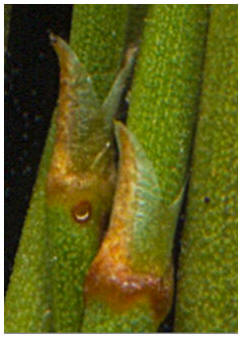 erect,
all mostly parallel to one another, spreading at an
angle of ~30°; leaves 2 per node, pale orange in lower half, or with
pale orange median strip, hyaline above, free to near base or united
to 4/5 their length, clasping to adpressed, not spreading,
deciduous except for basal thickened ring which turns reddish brown to
blackish resinous. Male cones spreading, with pale yellow or yellowish
green to flesh-colored bracts; female cones erect, sessile or on short to long s
to 5 cm or more; seeds two. peducled.
erect,
all mostly parallel to one another, spreading at an
angle of ~30°; leaves 2 per node, pale orange in lower half, or with
pale orange median strip, hyaline above, free to near base or united
to 4/5 their length, clasping to adpressed, not spreading,
deciduous except for basal thickened ring which turns reddish brown to
blackish resinous. Male cones spreading, with pale yellow or yellowish
green to flesh-colored bracts; female cones erect, sessile or on short to long s
to 5 cm or more; seeds two. peducled.
Widely
distributed in California chaparral and desert, 1,000–7,000 ft, to
Utah, New Mexico, Colorado, Oregon. Green ephedra ("Mormon tea") scrub recognized in MCV2
when ≥1% absolute cover and >30% relative cover with other species
as seen on hillsides above Sand Canyon Road.
Type from
Inyo Co.,
Coso Mtns. above Crystal Spring, CA.
Colville &
Funston 923, (June 12, 1891), annotated by Ickert-Bond May
2002, holotype (US!) [stems
dark green, leaves on young shoots long connate, shallowly notched near
apex, lobes rounded obtuse, occasional pollen cone at nodes]. Coville reported he could not find plants with seed.
Ft. Tejon
& vicinity, L.J.
Xantus de Vasey (1857-58), annotation Ickert-Bond,
May 2007; syntype for E. nevadensis det. by Ickert-Bond, Nov 2007
(US!). Kern Co.:
Occurs most often in pinyon-juniper forest regions of the Sierra Nevada, 360–2,028 m (CCH).
Noted by Twisselmann to be especially common in the pinyon woodland
around Frazier Park. CCH records also from the Temblor Range and
Inner Coast Ranges. Plants along the Kern River at southern end of Lake
Isabella for extensive ground cover by rhizomatous-like basal stems
branching from a reticulate network. Note: the image
of leaves shown here also are seein in E. cutleri (SEINet image).
Ethnobotanical (Moerman). Havasupai: Used as an emetic for
bowel complaints. Hopi: Tonic from stems with flowers for
syphilis. Kawaiisu: Stem infusion for anemia and backaches.
Navajo: Decoction new growth used as cough medicine; infusion of
stems for syphilis. Paiute: infusion of stems for diarrhea (for
children), or for rheumatism, colds, or to purify blood, stomach
ulcers, colds, regulating kidneys, or applied as powder to sores
(also Northern Paiute), to treat stomach ulcers. Shoshone:
Compound infusion to children for diarrhea; twigs as blood purifier;
powdered stems for burns; decoction of root or salted decoction of stems
as a physic, cold remedy Tewa: dried flowers and stems as tonic
for syphilis. Tubatulabal: Decoction of stems for syphilis.
Washo: Decoction of twigs or branch for delayed or difficult
menstruation.
Ephedra viridis is
generally recognized by the erect closely parallel
stems, and typically
has erect an branched woody trunk. Variation in the shape and the degree to
which scale leaves are united suggest distinct varieties or species.
Forms with long peduncled cones
as shown in the adjacent image from Frazier Park (May 2012), which might be interpreted by some as
belonging to E. coryi, even though cones of E. viridis
are described as not peduncled to shortly
peduncled, also occur elsewhere such as in New Mexico;
they are considered a variable feature of E. viridis (Sivinski
2010). However, other variation such as seen in the Piute Mountains include two tentatively
undetermined species.
One has erect branches, young brownish scale-leaves developing at shore intervals, and
short whorls of branches that appear deciduous (Ephedra sp. B), and a second has
divaricate branches that are 4-angled (Ephedra sp. A). Images of both are
shown above. Plants
on rocky benches above the Kern River just south of Lake Isabella have
longer transparent scale-leaves and also longer photosynthetic leaves.
Links:
SEINet,
Calflora, Calscape
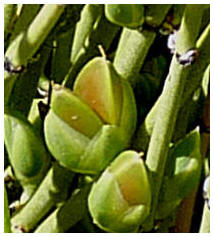
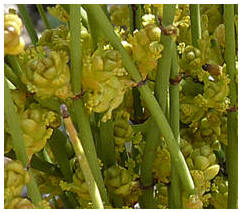
Ephedra viridis, seed and pollen cones
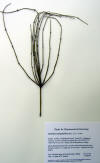


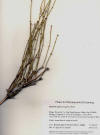








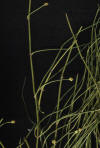






_small.jpg)
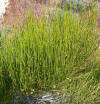

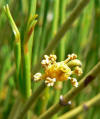
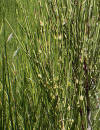











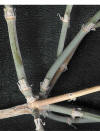



















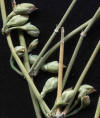







































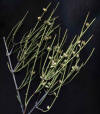




 erect,
all mostly parallel to one another, spreading at an
angle of ~30°; leaves 2 per node, pale orange in lower half, or with
pale orange median strip, hyaline above, free to near base or united
to 4/5 their length, clasping to adpressed, not spreading,
deciduous except for basal thickened ring which turns reddish brown to
blackish resinous. Male cones spreading, with pale yellow or yellowish
green to flesh-colored bracts; female cones erect, sessile or on short to long s
to 5 cm or more; seeds two. peducled.
erect,
all mostly parallel to one another, spreading at an
angle of ~30°; leaves 2 per node, pale orange in lower half, or with
pale orange median strip, hyaline above, free to near base or united
to 4/5 their length, clasping to adpressed, not spreading,
deciduous except for basal thickened ring which turns reddish brown to
blackish resinous. Male cones spreading, with pale yellow or yellowish
green to flesh-colored bracts; female cones erect, sessile or on short to long s
to 5 cm or more; seeds two. peducled.

